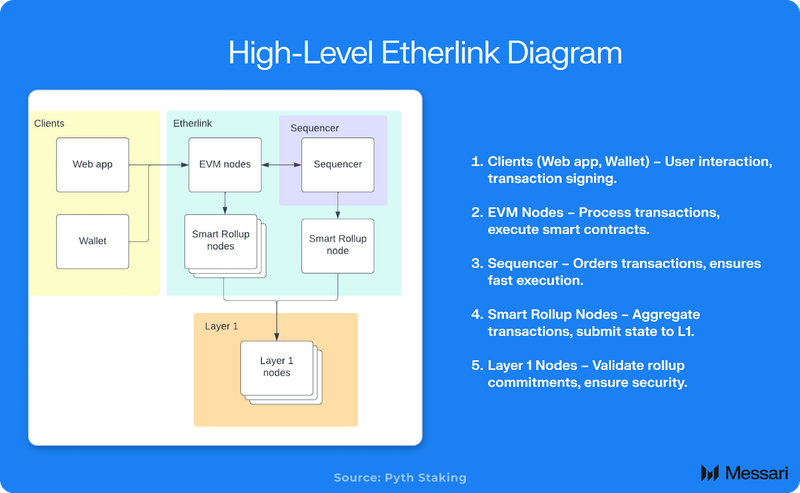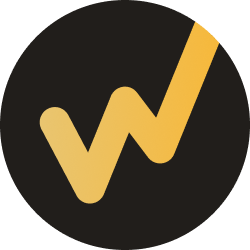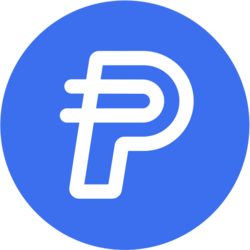Key Insights
- Sustained network growth is reflected in median monthly increases of 12.16% for accounts and 27.80% for transactions, indicating consistent adoption and on-chain activity. While early growth saw rapid expansion, these median rates provide a clearer picture of ongoing user engagement.
- Cost efficiency remains a defining feature, with an average transaction fee of $0.003. By leveraging Tezos Smart Rollups, Etherlink executes transactions in an isolated environment while maintaining security, reducing costs for both developers and users.
- Integrations with LayerZero, Stargate, and other cross-chain protocols allow for greater interoperability, enabling seamless asset transfers between Etherlink, Tezos, and EVM-compatible ecosystems. This cross-chain connectivity enhances liquidity flow and broadens the network’s accessibility.
- Over 50 projects are actively developing on Etherlink, spanning DeFi, gaming, and NFTs. Notable applications such as IguanaDEX, SuperLend, and Battlerise contribute to the growing ecosystem, reinforcing Etherlink’s role as a scalable Layer 2 for Tezos.
Primer
Tezos (XTZ) is a Liquid Proof-of-Stake (LPoS) blockchain network recognized for its emphasis on security, upgradeability, and on-chain governance. Its unique self-amending mechanism allows protocol upgrades without hard forks, promoting continuous evolution. Tezos supports smart contracts via the Michelson language, which facilitates formal verification and enhances security for decentralized applications (dApps). Recent upgrades, such as Mumbai and Paris, have focused on improving scalability and performance by introducing features like Smart Rollups and a Data Availability Layer (DAL) to handle higher transaction throughput and optimize data availability.
Etherlink, a community-supported Layer 2 solution for Tezos, plays a crucial role in this evolving ecosystem by providing Ethereum Virtual Machine (EVM) compatibility to enhance interoperability with Ethereum-based applications. By enabling cross-chain capabilities, Etherlink broadens Tezos’ appeal to developers familiar with Ethereum’s ecosystem. As part of the Tezos X vision, Etherlink is essential for achieving a scalable, composable, and interoperable network.
Website / X (Twitter) / Discord
Introduction to Etherlink
Etherlink is an EVM-compatible, non-custodial Layer-2 blockchain built on Tezos Smart Rollup technology, designed to provide a fast, low-cost, and scalable environment for developers and users. As a rollup to the Tezos Layer 1, Etherlink leverages the security, decentralization, and governance mechanisms of Tezos while offering seamless integration with Ethereum-based tools, including wallets, indexers, and developer frameworks. This allows for easy deployment of Ethereum-native applications on Etherlink with minimal modifications.
One of Etherlink’s defining features is its high-speed transaction processing. The network achieves sub-second confirmation times (~500ms) while benefiting from Tezos’ two-block finality, ensuring that transactions are finalized quickly and securely. Compared to other rollups like Optimism Bedrock (~2 seconds confirmation) and Arbitrum One (~300ms confirmation but ~7-minute data posting time), Etherlink offers a balance of speed and security. Additionally, Etherlink was built to be cost-effective; as of the time of writing, the average transaction fees are $0.003.
Security and decentralization are central to Etherlink’s design. The network operates without administrative keys or centralized bridges, ensuring that users maintain complete control over their assets. Etherlink also features a decentralized governance model, allowing stakeholders to propose and vote on upgrades, sequencer modifications, and security patches.
Etherlink facilitates cross-chain interoperability through integrations with protocols such as LayerZero and upgrades like Bifröst, enabling asset transfers between Etherlink, Tezos, and other EVM-compatible chains. Users can connect to Etherlink using popular wallets, including MetaMask, Coinbase Wallet, Trust Wallet, and Rabby Wallet, ensuring easy access to the network.
Since its mainnet beta launch on May 15, 2024, Etherlink has gained significant adoption. The network has recorded over 8.6 million transactions as of Q4 2024 and has seen a 272% increase in network fees collected, reflecting its growing user base. More than 50 projects are in development, spanning DeFi, gaming, and compliance-based applications. Some notable projects include:
- DeFi: IguanaDEX, SuperLend, Hanji, Uranium.io
- Gaming: Sugarverse, Battlerise
Etherlink continues to evolve through ongoing infrastructure upgrades. The Bifröst Network Upgrade (November 2024) introduced improvements to the FA 2.1 token bridge, optimized transaction indexing, and reduced latency for RPC calls, enhancing network efficiency. Additionally, the Calypso upgrade builds upon these advancements by enhancing network reliability, optimizing storage for rollup nodes, and introducing a precompiled contract entry point for faster XTZ withdrawals to Tezos L1.
Etherlink officially exited beta on February 25, 2025, transitioning to a production-ready status. This milestone, which coincided with the Apple Farm launch, marks a significant step in the network’s development, signaling its readiness for broader adoption and scaling within the Tezos ecosystem.
Etherlink Ecosystem

Etherlink’s ecosystem represents a growing interconnected network of infrastructure providers, applications, and integrations, reinforcing its role as a scalable and interoperable Layer-2 solution on Tezos. By enabling EVM compatibility, Etherlink allows developers to deploy Ethereum-based applications directly on Tezos’ Layer 2, using familiar tools without code modifications. This integration combines Ethereum’s developer ecosystem with Tezos’ security, energy efficiency, and governance, supporting a broader range of DeFi, NFT, and gaming applications.
The integration of cross-chain bridges such as LayerZero and Stargate expands Etherlink’s reach beyond the Tezos ecosystem, facilitating asset movement across multiple chains. This interoperability strengthens liquidity flows, making it easier for users and projects to access DeFi opportunities, NFT marketplaces, and gaming economies without being siloed within a single network. At the infrastructure level, oracles like Pyth and RedStone provide real-time data feeds, ensuring secure and reliable price information, while indexers such as The Graph and Goldsky optimize data accessibility for applications. Node operators, wallets, and developer tooling platforms work together to create a robust and decentralized environment where new applications can be built and scaled efficiently.
For Tezos, Etherlink’s expansion is intended to support broader adoption and developer engagement, enhancing the network’s position in the Layer-2 space. Historically, Tezos has prioritized self-amendment, governance, and security. Etherlink extends these principles by providing a low-cost, high-speed rollup solution that is compatible with Ethereum’s smart contracts and development tools. This compatibility is designed to make it easier for Ethereum-native projects to operate on Tezos without significant modifications.
Performance Metrics
Key performance metrics such as number of accounts and number of transactions provide insight into Etherlink’s adoption, network activity, and developer engagement.
- Number of accounts indicates the total user base interacting with Etherlink.
- Number of transactions measures on-chain activity, reflecting demand and network usage.
These metrics provide a snapshot of Etherlink’s current ecosystem, showing its scale, utilization, and development activity.
Number of New Accounts and Number of Transactions


To better assess Etherlink’s growth trends, we used the median monthly growth rate instead of relying on total percentage growth since launch. This method helps smooth out extreme spikes and provides a clearer picture of typical month-to-month increases. The median is calculated by sorting the monthly growth rates and selecting the middle value, ensuring that unusually high or low growth months do not distort the overall trend. This approach is particularly relevant for Etherlink, as its early growth included periods of rapid expansion that are not representative of its ongoing adoption rate.
Based on this calculation, the median monthly account growth rate stands at 12.16%, reflecting a steady increase in new users joining the network. While account creation is an important indicator of adoption, long-term success will depend on how many of these accounts remain active and engaged over time rather than just being created.
Transaction activity has grown at a faster pace, with a median monthly growth rate of 27.80%. This suggests increasing on-chain engagement, as more transactions are being processed through applications deployed on Etherlink.
Since the start of 2025, the number of transactions has increased from 4.5 million to 5.2 million as of February 19, reflecting a 15.48% rise in network activity. Over the same period, the total number of accounts grew from 117,474 to 120,620, marking a 2.68% increase. As Etherlink matures, additional metrics—such as active addresses, contract deployment rates, and sequencing efficiency—will provide a more comprehensive view of its adoption and performance within the Layer 2 ecosystem.
Etherlink Road Map and Tezos X Vision
Etherlink
Etherlink’s mainnet beta launched in May 2024, with a near-term focus on expanding the network through developer education and tooling. As of February 25, 2025, the public beta was completed and Etherlink became officially production-ready. Being part of the Tezos X roadmap, Etherlink will eventually become part of a ‘canonical’ rollup, enabling high performance as well as full composability and interoperability across development environments on Tezos. Key milestones in this roadmap include:
2025: Focus Areas
- Performance Improvements: Enhancements to throughput (TPS) to match that of competitors.
- DAL Integration Readiness: Preparing DAL for integration with Etherlink to accommodate increased throughput demands.
- Canonical Rollup Development: Transitioning Etherlink into a canonical rollup enabling multiple chains (such as Tezlink, JsTz, etc.) to coexist with super-fast asset transfers at the level of Layer-2 blocks or even transactions.
2026: Key Developments
- Michelson Rollup: Execution environment compatible with Tezos Layer-1 and instant asset transfer to Etherlink.
- JavaScript Rollup: Introduction of an execution environment using JavaScript, with the launch of the first JavaScript applications.
- Canonical Rollup: An integrated execution environment allowing instant transactions across applications written in different programming languages.
- Smart Contract Migration: Movement of applications from Layer-1 to the canonical rollup, enabling Layer-1 to be optimized for both very fast and very decentralized consensus/settlement.
Beyond 2026: Long-term Vision
- Achieving 1 million transactions per second in a single rollup.
- Reducing Layer-1 block times to 5 seconds.
TezosX
In 2024, teams at Tezos development hubs Nomadic Labs, Trilitech and Functori announced Tezos X, an ambitious roadmap designed to significantly enhance the scalability, flexibility, and utility of the Tezos ecosystem and eventually merge into a single, canonical rollup. It introduces key innovations that leverage Smart Rollups and the Data Availability Layer (DAL) to create a more interconnected and efficient blockchain environment. Etherlink is the first of many planned L2s that will make up the Tezos X ecosystem. By prioritizing composability and interoperability, Tezos X aims to establish Tezos as a leading blockchain for developers, enterprises, and users seeking a highly adaptable and future-proof network.
Core Innovations in Tezos X

Composability: Building a Unified, Scalable Ecosystem
A major focus of Tezos X is composability, which enables different applications to interact seamlessly and build upon each other, creating a network where the whole is greater than the sum of its parts. This is achieved through a canonical rollup, built on Smart Rollup technology, that allows smart contracts to function across various environments.
Interoperability: Expanding Tezos Beyond a Single Network
Tezos X introduces an enhanced interoperability model, allowing seamless integration with multiple programming environments, external blockchains, and even non-blockchain systems. This “plug-and-play” approach empowers developers to use their preferred programming languages and tools while maintaining cross-platform connectivity.
By eliminating traditional barriers to blockchain adoption, Tezos X will enable developers to create applications that can interact across different chains and networks, making Tezos a more accessible and versatile platform for both Web3 and enterprise developers.
Canonical Rollup: A Unified Execution Environment
At the heart of Tezos X is the canonical rollup, a new type of rollup designed to support multiple execution environments. Unlike traditional rollup architectures that limit developers to specific virtual machines or execution models, the canonical rollup allows smart contracts written in different languages—such as Solidity, Python, and JavaScript—to interact within the same transaction and rollup.
This means developers can build and deploy applications in the programming languages they are most comfortable with, while still benefiting from the security, decentralization, and efficiency of Tezos. The ability to mix and match programming languages within the same rollup significantly lowers barriers to entry, making Tezos more attractive to a broader range of developers, including those from traditional software backgrounds.
Tezos X is poised to transform how developers build and deploy decentralized applications by combining composability, interoperability, and a flexible execution environment. In a public demonstration, developers were able to show a network throughput of 1 million transactions per second by horizontal scaling of Smart Rollups (1,000 rollup nodes running in parallel). Etherlink, Tezos’ first Smart Rollup, sets the stage for future rollups and the vision of Tezos X.
Closing Summary
Etherlink has rapidly expanded since its launch, demonstrating significant adoption and ecosystem growth across DeFi, gaming, NFTs, and infrastructure services. Its integration with Ethereum-compatible tools, cross-chain bridges, and decentralized applications highlights its role as a scalable and cost-efficient Layer 2 for Tezos. The continued development of Etherlink’s ecosystem, coupled with infrastructure improvements and governance enhancements, will be essential in determining its long-term impact on Tezos and the broader blockchain landscape. As the network matures, new performance indicators and metrics will emerge, further shaping its position within the evolving multi-chain environment.




















